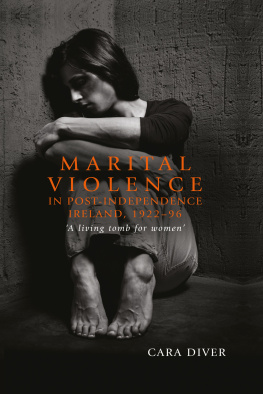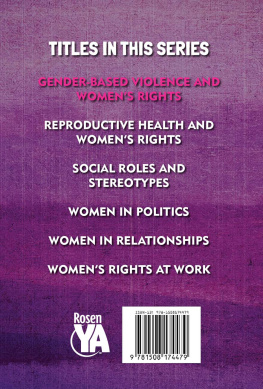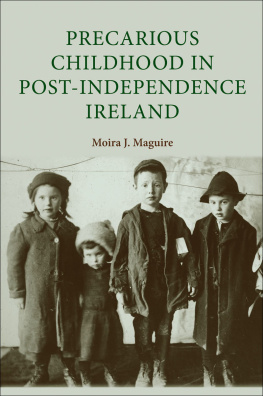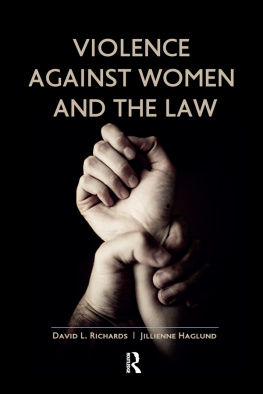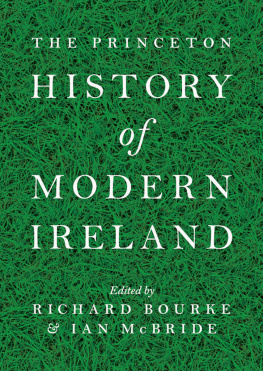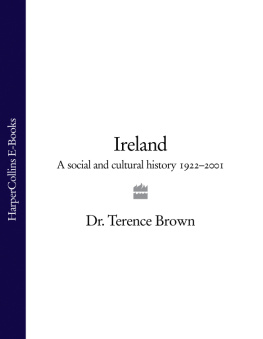Marital violence in post-independence Ireland, 192296

Marital violence in post-independence Ireland, 192296
A living tomb for women
CARA DIVER
Manchester University Press
Copyright Cara Diver 2019
The right of Cara Diver to be identified as the author of this work has been asserted by her in accordance with the Copyright, Designs and Patents Act 1988.
Published by Manchester University Press
Altrincham Street, Manchester M1 7JA
www.manchesteruniversitypress.co.uk
British Library Cataloguing-in-Publication Data
A catalogue record for this book is available from the British Library
ISBN 978 1 5261 2011 3 hardback
First published 2019
The publisher has no responsibility for the persistence or accuracy of URLs for any external or third-party internet websites referred to in this book, and does not guarantee that any content on such websites is, or will remain, accurate or appropriate.
Typeset
by Deanta Global Publishing Services
Contents
This book owes a great deal to the generosity and encouragement of many people. In particular, I would like to thank Professor Ian McBride, who provided me with guidance and support from the earliest stages of this project. Professor Pat Thane has been unendingly generous with her time throughout my research. Without her support and expertise, this book would not have been possible. Professor Diane Urquhart offered helpful advice and feedback and went out of her way to encourage me. I am grateful to Professor Joanna Bourke whose insights were invaluable in shaping the final product that is this book. Thanks is also due to Professor Maria Luddy, Professor Margot Finn, Professor Laura Gowing and Dr Melissa Prinz, who offered guidance at various stages in my research.
During the course of my research, I benefitted from the assistance of many wonderful professionals in archives and libraries. I am particularly grateful to the staff at the National Archives of Ireland, who directed me to relevant material and brought me box after box of court records. Thank you also to the staff at the National Library of Ireland and the British Library. Special thanks are owed to the High Court of Ireland for granting me access to closed materials. I am grateful that I was trusted with such sensitive materials, and I hope I have done them justice.
Thanks to Emma Brennan and the team at Manchester University Press for their professionalism and guidance. I must also thank the anonymous readers at Manchester University Press whose feedback contributed greatly to the finished product.
I will always be grateful to those who taught me history during my undergraduate career at Middlebury College, especially Professor Travis Jacobs, Professor James Ralph and Professor Amy Morsman. These gifted teachers taught me to look at history critically, to develop my writing skills and to have confidence in my own abilities.
Finally, thank you to my family, who have always believed in me and supported me in every way possible. My parents worked hard to make sure that I had every educational opportunity, and they offered me encouragement when I needed it most. My mother and Janet read several drafts of the manuscript, for which I am grateful. Thank you also to my children, Thomas and Gabriel, who were born during the course of this project. They have made writing a book so much more difficult but living so much more fun. Finally, my greatest debt is to my husband Fergal, whose support has been immeasurable. He made sure I had the time and space to complete this book, and he kept me laughing throughout the process.
AA | Alcoholics Anonymous |
ADAPT | Association for Deserted and Alone Parents |
AIM | Action, Information, Motivation |
CSW | Council for the Status of Women |
EEC | European Economic Community |
FLAC | Free Legal Advice Centres |
ICA | Irish Countrywomens Association |
IHA | Irish Housewives Association |
IRA | Irish Republican Army |
ISPCC | Irish Society for the Prevention of Cruelty to Children |
IWLM | Irish Womens Liberation Movement |
NAI | National Archives of Ireland |
NSPCC | National Society for the Prevention of Cruelty to Children |
NWCI | National Womens Council of Ireland |
RCC | Rape Crisis Centre |
Historians have shown that all types In order to understand violence, therefore, we must first grapple with its history.
This study explores the history of marital violence in post-independence Ireland, a subject that has yet to be tackled by historians. While interest in marital violence in Ireland (and worldwide) has surged since the 1970s with the advent of second-wave feminism, Linda Gordon notes that public discussions of the issue have been distorted by the lack of a history.and some families struggled to adhere to a strict code of Catholic morality. A sustained examination of the Irish family demands that we acknowledge the reality of marital violence.
This book takes as its starting point the founding of the Irish Free State in 1922 and ends with the passage of the Domestic Violence Act and the legalisation of divorce in 1996. Although many men beat their wives with impunity during the whole of the twentieth century, there was little public discussion of marital violence for the first fifty years of Irish independence. It was not until the early 1970s, with the arrival of the second-wave feminist movement, that the Irish discovered the problem of marital violence. Once the reality of spousal abuse was widely acknowledged, change quickly followed: activists established emergency refuges for battered women and their children, the government passed legislative reforms that provided protections for abused women, and the public began to more openly discuss the problem of marital breakdown. This study will ask why the issue of marital violence was not recognised for so long, and why it was suddenly brought to light in the 1970s.
For most of the period under review, the battered woman occupied an extremely vulnerable position. It was common for a chronically abused woman to remain with her violent husband because she had little money to support herself (or her children) and little recourse to the law. Due to womens inferior status, it is argued here that marital violence represented a social problem in post-independence Ireland: an abused woman had a socially constructed inability to escape her husbands violence as a result of her economic dependence, limited legal options, and social and religious expectations. Because so few women had a path of escape, this book considers the ways in which they learned to cope with their abusive partners and how they resisted and responded to the violence. Additionally, it examines the meanings that contemporaries from the troubled couples themselves to their local communities to legal professionals assigned to marital violence. By analysing the ways in which a wider audience understood and reacted to marital violence, we can draw broader conclusions about womens position within marriage and society, the nature of family life, and the relationship between family and community.

